« Diving Lake Tahoe! | Main | What to do between diving opportunities »
September 10, 2006
High Altitude Diving Certified!
I will not forget this day anytime soon. It was the day when I drove up to Lake Tahoe, dove Tahoe, and got certified as a PADI High Altitude Diver! I met Chuck Odell and his crew in Shingle Springs at 7:15AM and then we drove up into the Sierras on Highway 50 in convoy. The drive is very scenic and at times it's hard to keep your eyes on the road. There is just so much to see: forests and mountains and rocks and peaks and brooks and creeks in an ever-changing setting as you go higher and higher. 4000 feet, 5000 feet, 6000 feet... ears popping and you definitely can feel the altitude. The turbo motor in my PT Cruiser seemed totally unaffected; I was not. 7000 feet, and then Echo Summit at 7382 feet. As Chuck had requested, I mark the time when I pass the summit.
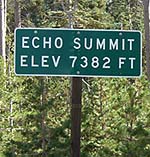 The air is much thinner up here. Which means the air pressure is lower. Since it took me all of an hour or so to drive up from Folsom which is essentially at sea level to Echo Summit, I am now the equivalent of a PADI P-diver. My body is dissipating nitrogen just as if I had just emerged from a dive. You add two PADI pressure groups per 1000 feet, so from zero to 8000 (you round up), it's 16 pressure groups once you reach the summit. Descending down to the Tahoe basin counts as surface interval time during which my body releases excess nitrogen. By the time I reach Meers Bay on the west side of Lake Tahoe and enter the water, an hour an a half will have passed. According to the PADI Recreational Dive Planner table, I will be a C-diver then.
The air is much thinner up here. Which means the air pressure is lower. Since it took me all of an hour or so to drive up from Folsom which is essentially at sea level to Echo Summit, I am now the equivalent of a PADI P-diver. My body is dissipating nitrogen just as if I had just emerged from a dive. You add two PADI pressure groups per 1000 feet, so from zero to 8000 (you round up), it's 16 pressure groups once you reach the summit. Descending down to the Tahoe basin counts as surface interval time during which my body releases excess nitrogen. By the time I reach Meers Bay on the west side of Lake Tahoe and enter the water, an hour an a half will have passed. According to the PADI Recreational Dive Planner table, I will be a C-diver then.
On the map it had looked like we'd just drive along the western side of Lake ahoe to arrive at the little state park that is Meers Bay. I wasn't prepared for some of the most scenic road I have ever been on, road that while more or less following the shore line, descended way up high for spectacular vistas. And it was a winding road to boot so I never quite knew what came first: my anticipation of the dives ahead, enjoying the terrific road, or marveling at the scenery around me. I did a bit of each.
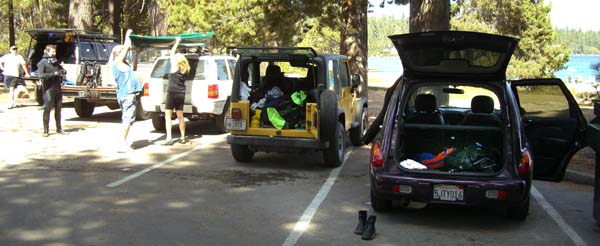
Meers Bay had a marina and a little resort but as far as state parks go, it is tiny. A machine takes your $5 bill and gives you a ticket, then it's on to the 20 parking spots or so. It's fairly brisk on this gorgeous September morning, though not nearly as chilly as on Echo Summit where the temperature had dropped to 43 degrees. It's perhaps 60 here, which feels cold to us spoiled Californians. We step out onto the picnick and beach area and marvel at how clean it is, and how beautiful. I go down to the shore and the water is just crystal-clear. None of the gunk and mud and garbage so prevalent in lakes and on beaches these days. Just sparkling, clean, wonderful water.
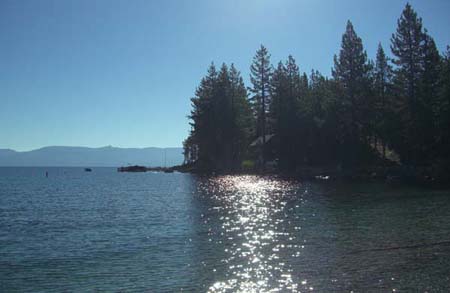
We grab a table and start shlepping our gear from the cars to the table. I am a worry-wart by nature and I am just SURE I forgot something crucial, despite having checked everything twice and despite having gone over the list with Carol. Miraculously it seems to be all there and accounted for, and so I carry my Stahlsack bag with all my gear to the table, bring over the big steel-95 tank, then change into my wetsuit. David, the student instructor Chuck is going to work with primarily, is checking out his gear, too, and wonders how he'll manage to get into his suit. Chuck makes it a bit easier by giving him a dive skin.
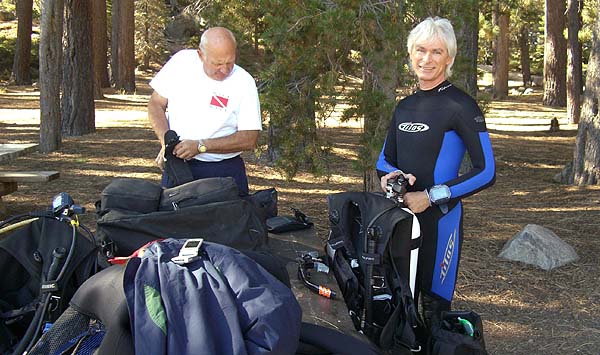
As we're almost all suited up Chuck declares that the water is a bit colder than expected and we should use gloves and hoods. I did bring my gloves, but I do not have a hood. Fortunately, Chuck has an extra and so this will also be the first time I'll be diving with a hood.
We go into the water, put on our BCs, struggle with getting the fins on (at least I struggle; I still don't have the hang of it), and then are ready to dive Lake Tahoe! Chuck explains the plan. Nevada requires a dive flag on the surface, so he'll have to bring that with us wherever we go. We'll first get used to the high altitude environment, then go down to perhaps 15 feet or so and he and David will do some of the mandatory PADI exercises. Then we'll go out farther until we reach the line where a 45 degree slope goes down many hundreds of feet. Lake Tahoe, you see, is almost 1700 feet deep.
So down we go. I am dazzled by the clarity of the water! Visibility seems at least 50 or 60 feet, and Chuck later confirms that. What a difference to Folsom Lake. The first thing we see is some small rocks that are the home of little Lobster-like crawfish. Chuck gently picks one up and shows him to us. The carwfish doesn't like it at all and shakes his claws. Chuck releases him and the little guy lunges right at me. I jump out of its way, which isn't nearly as easy underwater as above. Later I see much bigger ones of the same variety. Most seem quite combative, menacingly raising their claws when we take a closer look at them.
I then realize that all is not well with David. He can't descend! Not enough weight. So he and Chuck go back to the shore and add some more. Still not enough, and David ends up holding a large rock for most of the remainder of this dive. It looks rather funny. Eventually he and Chuck do their exercises and I am poking around, trying not to get too far away. The water is so wonderfully clear that I have none of the fear of getting lost. I am also quite pleased that Chuck neither gave me instructions nor appears to keep a close eye on me. I take that as an indication that he trusts me enough to let me do my thing. I am cautious, though, and stay close, just practicing floating around at neutral buoyancy.
I also monitor my dive computer and am pleased that I can read all the information on its screens, even without any sort of optical correction to accommodate my need for reading glasses on the surface.
Then Chuck takes us to the edge of the slope and down some. It's quite steep and so you go deep quickly. And the deeper you go, the less buoyant the suit becomes as the water pressure squeezes the air bubbles inside the suit, and so I have to compensate by adding air to my BC. I reach 40 feet and my sinuses hurt a bit. It's a weird feeling, and gets weirder as I look down the slope, knowing that it goes deeper than any human could dive on air. Then we go back up. Dive One done. It was terrific, it felt terrific, and I feel like screaming with joy as I surface. I think I actually did.
I used up more air during the 40 minute dive than I expected but everything else went well. The hood felt a bit weird at first, but there was no leakage. The gloves meant I had to move the dive computer farther up my arm, and there's no feeling in your fingers with gloves on, but it all worked just fine. And the gear kept me nice and warm during the entire 40 minute dive.
I had sort of expected a lecture from Chuck on what pressure group we were in now and so on, and a quiz on how long we should stay on the surface for however deep we were going to go on the enxt dive and so on. None of that, though, and I didn't even have time to change tanks before we were back in the water for Dive Two.
This one turns out to be my best dive yet! We again go down fairly close to the shore so David can do more of his mandatory exercises, and that includes the ever popular emergency diving ascent. While they do that I poke around and, since we are close to the slope and the water is clear enough for me to see both the diving line and Chuck on the surface, I decide to go down the slop a bit. 30 feet, 35 feet, 40 feet, 45 feet, 50 feet, 55 feet... The line now looks a little fainter, but I feel a great need to explore more. So I go down a few more feet, but then turn. I don't want for Chuck to think I am irresponsible, and I sure do not want to get lost having done this little excursion all by myself. So I add a bit of air to my BC and go back up. The computer shows that I reached 58 feet, by far a new record for me. And there's the dive line. In no-time I am back there. I feel elated!
But that is not all. Check points in a direction away from what I know is the shore and beckons us to follow him. I swim up to him, tap his arm and point at my computer gauge that shows tank pressure is down to less than 1000 psi. No problem, signals Chuck.
So we swim off and encounter perhaps the most amazing sight I have ever seen: a landscape full of giant rounded boulders, submerged at perhaps 35 feet ot water. It looks otherworldly and I feel a sense of wonder as I swim towards them and then around them. It's incredible. Chuck points to an area between two of the boulders and I see a school of silvery fish, many hundreds of them. I look at them, see them dart, in unison, this way and that, but also anxiously look at my pressure that has now reached just 500 psi.
On we swim, back into shallower water. It's just sand now with some old logs here and there, and an old rusted engine block. I tap it and rust flakes come off. We swim closer to the shore and then go up, with my tank down to 350 psi. I break the surface, high-five David, and again just want to scream with joy.
So those where my first high altitude dives. Turns out I did forget something -- my logbook! So Chuck cannot sign my dive logs and I have to fill them out later. Oh well. Other divers are milling around, and I see a couple with rebreathers. We talk a bit, then decide to head for Tahoe City to have lunch. That'll give us time to dissipate nitrogen and for me to get ready to ascend for Lake Tahoe (6200 feet) back up to Echo Summit. On the way back I stop at several lookouts and marvel at the scenery. Beautiful, so beautiful. I decide I want to come back diving here as soon as I can.
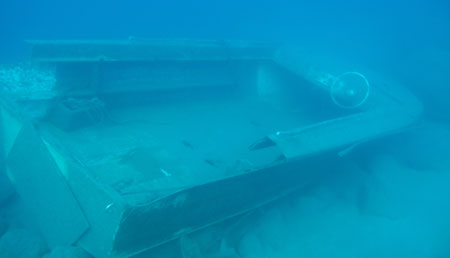
Posted by conradb212 at September 10, 2006 10:59 PM








